Text
Upcoming Posts!
1. Traditional Japanese Clothing
2. Writing Mental Illness - Psychosis
3. Norse Mythology - Yggdrasil and the Nine Worlds
1 note
·
View note
Text
Scandinavia - Old Norse Poetry - Structure and advice on writing imitations
(Some of this will be copy-pasted from my previous post on Old Norse literature and oral tradition)
OLD NORSE POETIC FORMS
Old Norse poetry utilizes a modified form of alliterative verse. In simpler terms, the metrical structure is not necessarily based on the last syllables of a line or phrase rhyming...
Ex: (lines from William Shakespeare’s Venus and Adonis) “And so in spite of death thou dost survive / In that thy likeness still is left alive”
... the structure relies on the repetition of multiple initial consonants in a line or phrase.
Ex: (from the Hávamál of the Codex Regius) Deyr fé // deyja frændr
SKALDIC POETRY
Primarily documented in sagas, skaldic poetry is usually about history, particularly the celebrated actions of kings, jarls, and some heroes. It typically includes little dialogue and recounted battles in dialogue. It has more complex styles, especially using dróttkvætt and many kennings.
DRÓTTKVÆTT (“courtly metre”)
- Adds internal rhymes and assonance (repetition of both consonants AND vowels) beyond the normal alliterative verse
- The stanza had 8 lines, each line usually having 3 lifts (heavily stressed syllables) and almost always 6 syllables
- The stress patterns tends to be trochaic (stressed, unstressed), with at least the last 2 syllables of a line being a trochee (usually...)
- In odd-numbered lines (first line, third line, etc.): 2 of the stressed syllables alliterate with one another; two of the stressed syllables share partial rhyme of consonants with dissimilar vowels (ex: hat and bet; touching and orchard)
- In even-numbered lines (second line, fourth line, etc.): the first stressed syllable must alliterate with the alliterative stressed syllables of the previous line (an odd-numbered line); two of the stressed syllables rhyme (ex: hat and cat; torching and orchard)
These requirements are SO difficult that oftentimes poets would mash together two separate lines of writing in order to meet the structure. It’s really hard to explain, so read the wikipedia link here for more info.
KENNINGS
Kennings are figures of speech strongly associated with Old Norse-Icelandic and Old English poetry. It is a “type of circumlocution, a compound employs figurative language in place of a more concrete single-word noun” (source).
Now, when I first read that, I had zero clue what the hell that meant. But this is my current understanding: a poetic device where you dance around using a single noun by describing it with other words. It is similar to the poetic device of parallelism.
- “bane of wood” = fire (Old Norse kenning)
- “sleep of the sword” = death (Old English kenning)
- Drahtesel = “wire-donkey” = bicycle (modern German kenning)
- Stubentiger = “parlour-tiger” = house cat (modern German kenning)
- Genesis 49:11 “blood of grapes” = wine
- Job 15:14 “born of woman” = man
A beautiful resource for translated kennings is this article here from the HuffPost’s Harold Anthony Lloyd.
SIMPLE KENNINGS
Simple kennings would be used in both Eddic and Skaldic poetry.
The usual forms are a genitive phrase (ex: the wave’s horse = ship) or a compound word (sea-steed = ship). There is usually a base-word and a determinant.
The determinant may be a noun used uninflected as the first element in a compound word, with the base-word being the second element of the compound word.
OR the determinant may be a noun in the genitive case placed before or after the base-word, either directly or separated from the base-word by intervening words. The base-words in the above examples are “horse” and “steed”, while the determinants are “waves” and “sea”.
The unstated noun which the kenning refers to is called its “referent”, in the example a bit above: ship.
COMPLEX KENNINGS
More complex kennings are really only used in skaldic poetry.
In these, the determinant and sometimes the base-word are themselves made up of kennings. A matryoshka doll of kennings, if you will.
Ex: “feeder of war-gull (bird)” = “feeder of raven” = “warrior” (referring to how warriors kill people and leave their corpses for birds to eat)
The longest kenning in Skaldic poetry belongs to Þórðr Sjáreksson’s Hafgerðinga where he writes “fire-brandisher of blizzard of ogress of protection-moon of steed of boat-shed”, which means “warrior” (source).
EDDIC POETRY
Eddic poetry is usually about mythology, ethics, and heroes, and is narrative (where both the narrator and the characters are speaking). They use simpler structures, like fornyrðislag, ljóðaháttr, and málaháttr, and use kennings more sparingly.
FORNYRÐISLAG (”old story metre”)
- Each line tends to be a whole phrase or sentence (or end-stopped), where a sentence won’t “run over” and onto the next line (or enjambment).
Ex: End-stopped, from William Shakespeare’s Romeo and Juliet “A glooming peace this morning with it brings. / The sun for sorrow will not show his head.”
Ex: Enjambed, from T.S. Eliot’s The Waste Land “ Winter kept us warm, covering / Earth in forgetful snow, feeding / A little life with dried tubers.”
- Each verse is split into 2 to 8 (or more) stanzas.
Ex: from Waking of Angantyr (structure provided by wikipedia)

- There are 2 lifts per half line, usually with two or three unstressed syllables. At least 2 (but usually 3) lifts will alliterate, always including the main stave (the first life of the second half-line). This means there are usually between 4 and 5 syllables per half line, and therefore between 8 and 10 syllables per full line (but it can vary).
MÁLAHÁTTR (“conversational style”)
- Similar to fornyrðislag, but there are more syllables in a line.
- It adds an unstressed syllable to each half-line, making the typical 2-3 per half-line and 4-6 per line into 3-4 per half-line and upwards of 6 unstressed syllables per line
LJÓÐAHÁTTR (“song” or “ballad metre”)
- Usually made up of stanzas with four lines each
- Odd numbered lines were usually standard lines of alliterative verse with 4 lifts and 2 or 3 alliterations. It was cut in half with a “cæsura” or “//”, which indicates the end of one phrase and the beginning of another.
- Even numbered lines had 3 lifts and 2 alliterations, with no cæsura.
Ex: from Freyr’s lament in Skírnismál (structure provided by wikipedia)

WRITING IMITATION
When writing an imitation of Eddic and Skaldic poetry, there are many workarounds if you don’t want to jump through these hoops.
Personally, I am putting forward my imitation as a “translation” of an Old Norse text so I don’t need as much concern for alliteration, rhymes, and exact syllables.
But I enjoy having a similar feel to the original poems, so I do try to put in some alliteration for words that are of Norse/Germanic origin and keep a similar syllable count.
Posted: 2023 May 29
Edited last: 2023 May 30
Writing and research by: Rainy
2 notes
·
View notes
Text
Scandinavia - Old Norse Poetry - Literature and Oral Tradition
The following post describes the literature and oral traditions of Scandinavian peoples during the times of the Vikings. I describe the difference between skaldic and eddic poetry and define kennings.
A later post will have my resources and advice on writing imitations of both types of poetry. (Find it here!)
There are few primary sources of Scandinavian history and stories from the times of “Vikings”, or from the late 8th century to the late 11th century. There are artifacts with runic writing, but these are short and few in number. Most of the documents about Scandinavians written during their time are from outside sources (and often they are biased against the Norsemen) (source).
In the late 11th and early 12th centuries, Christianity and its method of writing in Latin was introduced to Scandinavia. After Latin was introduced, the oral traditions began to be recorded by a variety of authors, though the most notable is Snorri Sturluson (who compiled the Prose Edda) (source).
The most important to study of the Old Norse languages and the mythos of these peoples are the Poetic Edda and the Prose Edda.
“The Poetic Edda is the modern name for an untitled collection of Old Norse anonymous narrative poems” (source). There are several versions, and the most notable is an Icelandic text called Codex Regius from the 1270s CE which has 31 poems. These poems were not written by any one poet, but were collected and recorded from oral tradition. The exact age of these poems are unknown, but are considered to be the only direct records of Norsemen from their times.
The Prose Edda “is an Old Norse textbooks written in Iceland during the 13th century”. Its major and most well known contributor is Snorri Sturluson, a scholar and historian. The contents of the book are accounts of Old Norse mythology. Many of its sources are the same poems documented in the Poetic Edda.
Now, more on Old Norse poetry. For the most part, history and stories of the time of Vikings were passed down orally in two types of poetry.
Skaldic poetry (named for their creators: skald, or court poets) mostly regarded history and celebrated kings and jarls. It typically included little dialogue and recounted battles in detail. In comparison to Eddic poetry, Skaldic verse tends to be more complex in style and uses dróttkvætt. It also uses more kennings. While not proven, there is some speculation that skald accompanied their verse with a harp or lyre (source). It is mostly recorded in sagas.
Eddic poetry (named for the book they are compiled in: the Poetic Edda) is narrative, where there is both a narrator and characters speaking. They are characterized by their focus on mythology, ethics, and heroes, as well as a simpler way of verse (using fornyrðislag, ljóðaháttr, and málaháttr). It uses kennings, but less extensively than Skaldic poetry. It is mostly dialogue (source 1, source 2).
Kennings are figures of speech strongly associated with Old Norse-Icelandic and Old English poetry. It is a “type of circumlocution, a compound employs figurative language in place of a more concrete single-word noun” (source).
Now, when I first read that, I had zero clue what the hell that meant. But this is my current understanding: a poetic device where you dance around using a single noun by describing it with other words. It is similar to the poetic device of parallelism.
- “bane of wood” = fire (Old Norse kenning)
- “sleep of the sword” = death (Old English kenning)
- Drahtesel = “wire-donkey” = bicycle (modern German kenning)
- Stubentiger = “parlour-tiger” = house cat (modern German kenning)
- Genesis 49:11 “blood of grapes” = wine
- Job 15:14 “born of woman” = man
In a later post I will go into further details of the exact format of the two types of poetry. But it will be in the context of writing imitations.
Posted: 2023 May 29
Last edited: 2023 May 30
Writing and research by: Rainy
#vikings#poetic edda#prose edda#snorri sturluson#viking poetry#skald#skaldic poetry#kennings#kenning#eddic poetry#edda#old norse#old norse poetry#norse poetry
0 notes
Text
Masterlist of my own posts
JAPAN
Traditional Makeup - Recipes
SCANDINAVIA AND VIKINGS
Old Norse Poetry - History and overview of literature and oral traditions
Old Norse Poetry - Structure and advice on writing imitations
0 notes
Text
Japan - Historical Makeup - Recipes
Image: A modern-day geisha wearing traditional makeup

(Source: Chris Rowthorn Tours: Japan)
The historical makeup trends of Japan are much less popular in the modern age but are still seen on geisha, maiko, and kabuki actors. In this post, I will talk about pre-modern Japanese makeup.
The makeup routine has many steps and products that vary throughout the time periods. But the constant ones are: facial powder (oshiroi), rouge (beni), and charcoal. White, red, and black.
First, I will go over the ingredients and recipes. The trends will be discussed in another post.
ISHINERI AND BINTSUKE ABURA (primers)
Image: A modern-day tub of bintsuke abura

(Source: Geisha of Japan)
While not necessary, it is a good idea to prime the face before applying makeup.
Abura, or primer, is made of wax or a wax-like substance. It protects the skin from sweat and the intense makeup. While using a primer is better for the skin than not, using abura every day can cause skin problems as the skin can’t “breathe” with the coverings over it (source). Another plus of using abura is that the user now has a smooth surface to apply oshiroi. Now the skin will look incredibly smooth, even if the natural skin has blemishes to it.
Abura is prepared for use by taking a small amount of it and warming it in your hands and applying thinly over the face.
While unclear if this is true of past makeup, modern wearers of traditional makeup use two types of abura. Ishineri is wax used to flatten out one’s natural eyebrows, and bintsuke is wax or oil that goes over the skin of the face.
After prepping the face with abura, oshiroi can be applied.
OSHIROI (lit. “white powder”)
Image: Modern-day geisha named Kikuyae applying oshiroi

(Source: Geishakai)
The base for the makeup is a thick white paint. Oshiroi is prepared as a powder, and then added to water and mixed right before applying. It is painted on with brushes and smoothed out with sponges.
While the recipe of oshiroi has changed over the years, its use has been constant.
In the Nara and Heian periods (710-794 CE and 794-1185 CE, respectively), women painted their faces with oshiroi in order to lighten the appearance of their skin, though it was not the stark color shift we see in the image above. For the most part, the use of makeup was practiced by wealthy women.
I found it difficult to find records of makeup during the years between 1185 CE and the beginning of the Edo period in 1603 CE, but it appears that the shift to pursuing a stark color change (as we see in modern oshiroi wearers) was solidified in the Edo period (source).
In the Edo period, the main ingredient for oshiroi was either white lead powder or mercury powder. Starting in this period, common women wore makeup everyday. Common women used lead, while wealthy used mercury (as it was more expensive) (source). Now we know that these ingredients have bad side effects, so they are no longer used. Alongside these metal powders, ingredients like zinc oxide and seashells were used (source).
Modern oshiroi is made with zinc oxide (still), corn starch, magnesium carbonate, talc, and kaolinite (source).
BENI (crimson red powder)
Image: A 1920 CE woodblock print by Hashiguchi Goyo of a woman applying beni to her lips

(Source: Glamour Daze)
Beni is used as rouge for lips and cheeks, adding color to the white canvas provided by oshiroi. It is also applied with brushes.
Beni is traditionally made with crushed safflower petals. The flower was first cultivated in Mesopotamia (modern day Iraq and parts of Iran, Kuwait, Syria, and Turkey) as early as 2500 BCE (source). After going to India, and then to China (via the Silk Road), safflower ended up in Japan between the 2nd and 5th centuries CE (source).
Safflower can be used for many things, but its major boon is that it can be used as a substitute for saffron, which is more difficult to grow and more expensive. Safflower is used in culinary oils and dyes for clothing and cosmetics (source).
The petals of fresh safflower are orange/yellow. The petals are crushed into a paste and then washed with water to remove the water-soluble yellow pigment. The red pigment is extracted using multiple alkaline baths (the more baths, the most strong/deep the red) (source).
Safflower (or benibana) was first used as a dye in the Nara period of 710-784 CE. It was used in art for painting in red but then was used by noblewomen beginning in the Heian period of 794-1185 CE for cosmetics. Since beni is difficult to produce and expensive, the pigment is used sparingly, unless one is showing off their wealth.
Besides safflower petals, red bugs and mineral oils are also used to make red pigment. The pigment is mixed with water and applied with a small brush.
Beni is painted on the lips, though the exact designs vary depending on the individual and the trends of the time (I will go into more detail later on in the post); on the eyebrows, or historically a little higher than the original eyebrows alongside some black pigment (again, more detail later); and around the eyes. It can also be applied VERY LIGHTLY to create a pale pink contour for the face.
CHARCOAL
Charcoal is used to draw in the eyebrows and line the eyes (source 1, source 2).
OHAGURO (lit. “black teeth”)
Image: A maiko with blackened teeth

(Source: Geisha of Japan)
Ohaguro is the custom of blackening one’s teeth with a dye that is painted on. Covering the teeth prevents them and the enamel from decaying. The dye fades quickly and is applied once a day or every few days to keep the dark shade even (source).
First, a dark brown solution is made of iron filings dissolved in vinegar. Then the solution is combined with vegetable tannins (biomolecules) which turns it black and insoluble in water (source).
To prepare the teeth for painting, they are rubbed with the peel of a pomegranate, which forms a sort of adhesive surface for the dye. Then the dye is prepared and painted on. Afterward, people gargle water to get rid of excess dye.
While the exact origin of this practice is still unclear, having blackened teeth eventually became a sign of beauty.
Ohaguro first appeared among noblemen and noblewomen of the Heian period (794-1185) and then spread to include women of all social classes. In the very beginning, it was a rite of maturity for girls, but by the end of the Heian period, it was something almost all noblemen did.
In the Kamakura period (1194-1333), samurai upon passing their genpuku or initiation ceremony at age 15 or 16 would begin to dye their teeth. Ohaguro was originally only for noble people, but eventually it was alright for geisha and married women of all social classes to perform it.
During the Muromachi period (1336-1573), ohaguro was part of the rite of passage of maturity for both boys and girls. When girls got married, their female relatives would teach them how to blacken their teeth.
Nearing the end of the Sengoku period (1467-1638), men engaging in ohaguro became less and less common.
During the Edo period (1603-1867), the only men blackening their teeth were of the Imperial Family or of the aristocracy. Women only blackened their teeth if they were getting married or engaged, sex workers, or geisha.
In 1870, ohaguro on men was banned. And from then on the practice became less and less common, especially among married women and noblewomen.
Until the end of the Meiji period (1868-1912), ohaguro was still popular among the middle and lower classes. And in the Taisho period (1912-1926), it virtually disappeared except among elderly women in rural areas.
Nowadays, ohaguro is really only seen at festivals, period films, kabuki, and in some geisha districts wherein maiko have their teeth blackened in the last stage of their apprenticeship before becoming geisha.
(Source for entire ohaguro section)
MVP Sources (Very helpful to have open when doing research or writing :D)
[1] - A step-by-step tutorial on how a modern-day geisha or maiko applies their makeup. They use modern ingredients and supplies, but the process is similar.
[2] - A shorter tutorial than [1], but covers the main points.
[3] - Google Arts & Culture article on the process of making beni from safflower petals and the different methods of sale (powders, rouge tubes, etc.)
Posted: 2023 May 29
Last edited: 2023 May 29
Writing and Research by: Rainy
#worldbuilding#geisha#japanese makeup#oshiroi#beni#ohaguro#abura#traditional japanese makeup#traditional makeup#japanese tradition#research#makeup#japan
0 notes
Text
Worldbuilder’s Union Discord Server
I have made a discord server for people who like to build worlds, characters, languages, etc.!
This includes D&D, fanfic writers with considerable non-canon additions, or original content writers who write for sci fi and fantasy!
Here’s the link to join!
2 notes
·
View notes
Text
About me
I am a 19 year old university student and writer. I write lots of fanfics and original stories. I do a lot of world and language building for fun and wanted to put all of the stuff I use in one spot.
Also, I am white and not religious, so while I do go through a TON of research, it is still totally possible that I am being a douche or totally incorrect about something. Feel free to comment or message me if something I’m saying is douchey or wrong. Odds are I don’t mean it and want to do things right. <3
TBH, most of this writing is just so I can have clear notes because my google docs drive is suffering, so I’ve gotta move my notes elsewhere. But if other people can benefit from them, I would be so happy.
0 notes
Text
Natural Hair Care During Adventures / Apocalypse / Modern / Historical settings
Caring for natural (curly) hair in a setting with no access to modern hair products
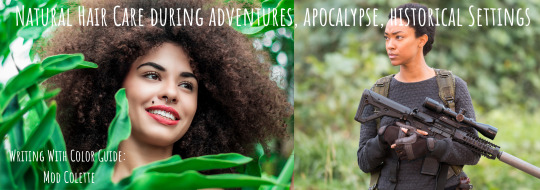
So it’s the apocalypse. Your curly-haired character is on the run. They find themselves on an adventure in a fantasy world. It’s a castaway story. Or the whatever-eth century and they’re in an environment that doesn’t exactly accommodate curly, coily haired types.
Either way, manufactured hair products are far and few between, or they’re simply not made for afro hair. Considering how your Black character handles their hair in this environment makes their circumstances more realistic and relatable.
Topics Featured in this Guide:
Hair Products found in Natural Environment
Hair Oils - Benefits and How To Extract
Protective Hair Techniques & Styles
Curly Hair Types & Hair Needs
Hair Routine Samples
Hair Straightening
FAQ
There is a writing takeaway at the end of each topic.
Brief descriptions provided after images. Contact me for fully accessible version.
Hair Products found in Natural Environment
Consider the essential needs of afro hair: water and fat.
Water (or liquid) is essential for nourishing the hair.
Fat (hair oils, creams, butters) is essential for both growth and protection.
Many curly-haired folks already use natural resources and plants to care for their hair - aka DIY hair-care. So characters concocting their own products should not be a strange concept. (I personally buy most of my natural hair products, and create my own hair masks, protein treatments, and oil blends.)
What they could use would depend on environment, time, and availability.
Hair Healthy Produce

Coconut - The all-purpose hair aid with multi forms, from oil to solid cream. Hardens in cold weather; best not to use when environment has freezing temps.
Banana - Typically removed after use (hair masks, conditioners)
Avocado - Applied as hair products, masks, and oils.
Strawberry - Mashed and applied directly to hair or mixed with oils.
Hair Healthy Proteins, Plants, Fats
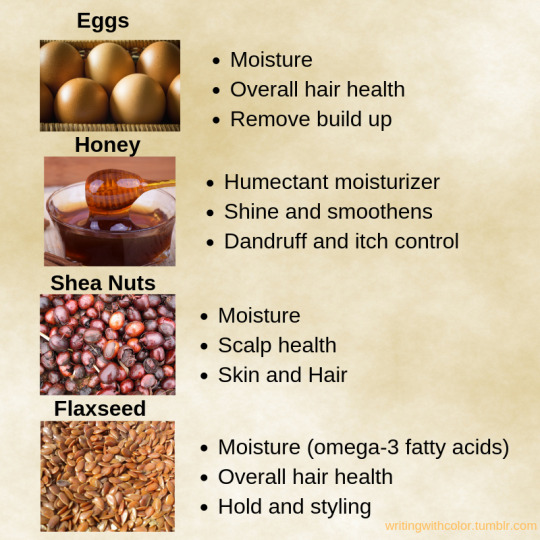
Eggs - Hardens when dry. Strong odor. Removed after use. (protein masks)
Honey - Pulls moisture from air into hair - avoid during the dry winter!
Shea Nuts - Made into shea butter. All-purpose hair and body care.
Flaxseed - Gel made by boiling & straining flax seeds. Many DIY videos online.
Hair Healthy Herbs and Flora

Hibiscus - Sebaceous = oil-producing gland. Flowers crushed into paste or oil.
Peppermint - Can rub out oil from leaves. Often used in oil form on scalp.
Lavender - Often used as an oil directly applied to the scalp, or brewed as tea.
Rosemary - Often combined with olive oil in use with hair; can be used alone.
More Hair Healthy Herbs and Flora
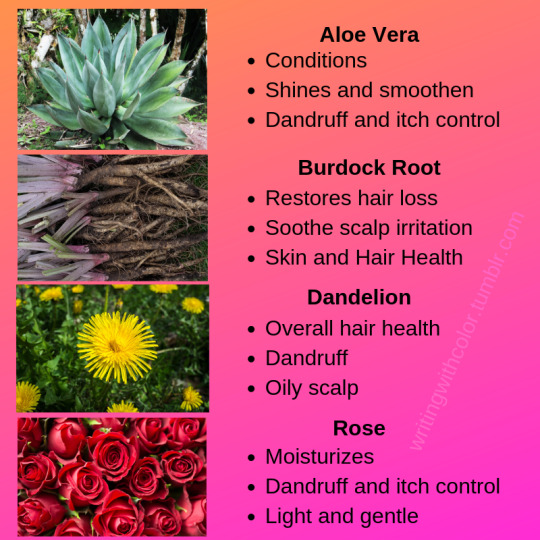
Aloe Vera - Succulent. Can extract sap directly from leaf and apply like gel.
Burdock - Contains essential fatty acids and phytosterol compounds.
Dandelion - Can use the roots, stems, leaves and sap for hair and skin.
Rose - Common use is rose water: steep roses in boiling water to create.
Hair Healthy Products (rare or require effort to make/find)

Apple Cider Vinegar (ACV) - Diluted before use and often washed out after.
Bentonite Clay - Aged volcanic ash. Combined with ACV for best activation.
Oils - Key component for sealing moisture. See the next discussion.
Yogurt - Base of many DIY hair products like masks and deep conditioners.
Oils for Hair
Oil is a key component to afro hair care. It nourishes and seals in moisture. Let’s discuss common hair oils and extraction methods that could, more likely, be done using homemade or historical equipment.
Oil Extraction
If oils aren’t readily available to purchase, the person would need to find or create tools to either extract the oil via pressing or heat the nuts or seeds. Consider the basic tools that have been around since ancient times. For example, the mortar and pestle. What creative use can be made out of existing tools in the person’s environment?
Hair Oils and Benefits (by potential ease to extract.)
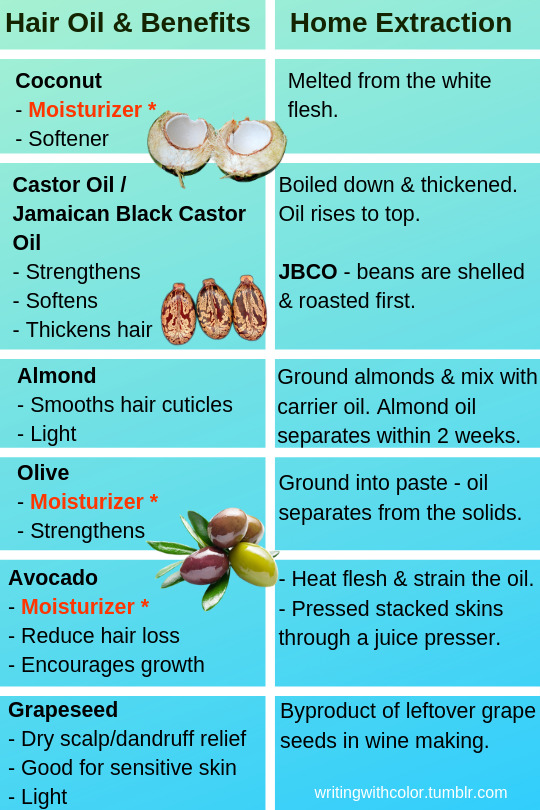
Coconut Oil, Castor Oil, Almond Oil, Olive Oil, Avocado and Grapeseed Oil.

FYI: These aren’t the only methods or necessarily professional means of extraction. I also left off hair-healthy oils that seemed complicated to extract without high-grade equipment. So, this isn’t an all-inclusive list of oil or methods.
Natural Hair Product Creation
So what exactly would your character create? Here’s some natural hair products and potential main ingredients. May be used alone or combined.
Leave-in moisturizers: Plain water, coconut water, rose water
Leave-in creams: (protect/style) honey, shea, aloe vera, flaxseed, flora
Hair Cleansing Conditioner: plant water, coconut, honey, light oils
Hair Rinse/Co-wash: Apple cider vinegar, coconut, brewed tea water
Hair Masks: Mashed fruits, yogurt, proteins (eggs), clay, honey
DIY Recipe Search: Try keywords like “DIY natural hair” + “curly hair” “Afro hair” or search all natural hair products and read over the ingredient list. Try small home business and independent sellers (Like etsy)
More Sources:
15 DIY Hair Recipes for Almost Every Step in Your Regimen
14 Homemade Leave-in Conditioner Recipes
Best DIY Recipes for Naturally Curly Hair
Product Storage:
Most homemade products last everywhere from a few days - weeks
Extend the life of spoil-prone products via the cooling system in the work.
Honey does not spoil. Be mindful if it’s mixed with spoil-prone ingredients.
Oils can usually be kept at room temperature and last a long time.
Keeping a small bit of ready made supply may prove time-efficient. If impossible, they may opt to use products that don’t require much time and effort, and are worth their time to make in small batches or to potentially dispose of after.
Writing Takeaway - Natural Product/Oils Creation
With just the above compounds, I can see creative naturals being able to create styling products and moisturizing leave-ins, shampoos, conditioners and hair masks.
Do consider the following:
How simple or complex can their regimen be?
Would they rely more on protective hair styles in their situation?
What is the natural environment: what products are accessible?
How will they store products or must they make a new batch each use?
Can items be purchased by craftsmen or found in abandoned locations?
Can they afford to use edible plants if food is scarce? Food scraps and non-edible plants (like the flora) might be what they rely on.
What are their specific hair care needs? -Discussion on this later-
Natural Hair and Styling
LOC Method as base style
Moisture, sealing in the moisture, and protection are the basic needs for natural hair. The Liquid, Oil, and Cream (LOC) Method, or a variation of the steps, fulfills those basic needs. It can be treated as both a care routine and a style in itself. Personally, if my hair is not in a protective style, I use it every week.

Liquid - Liquid opens hair cuticles to allow moisture to enter hair strands.
Oil - Once cuticles are opened, the oil penetrates hair & seals in moisture.
Cream - Cream further locks in the moisture, and can be used as a styling agent as well to shape and define curls.
Should you use the “LOC method” by name in your work?
A modern setting? Sure. But don’t assume readers know what it means.
A fantasy setting? Probably not, unless earth and its terms carry over.
A historical setting? No. It is a newly coined term.
Protective Hair Styles
Protective hairstyles protect the hair by tucking ends away from the elements. For example, heat, air, hand and fabric manipulation. While not forever solutions (except maybe locs which are a permanent style) there’s many benefits to your character’s wearing them.
Benefits:
Hair growth retention
Saves time styling hair
Helps prevent damage and keep hair healthy
Ideal for any natural (the best style itself may depend on hair type)
Lessens hair’s need and dependence on moisture and hair products
Eliminates some hair maintenance activities (such as detangling)
Considerations:
Hair more difficult to wash and dry thoroughly.
Dryness (unable to access all tucked away hair to moisturize)
Styles kept in too long accumulates dead skin and product build up.
Uninstalling styles can be time consuming, and should be done gently.
Style gets frizzy from growth overtime and/or getting soaked in water.

Protective Styles Short-term (lasting days to weeks)
Afro puff(s) or bun(s)
Back Tuck or Roll and Tuck
Bantu knots
French roll
Pompadour
Roller set
Two-strand twists
Wash and go (low manipulation style)
Shaved (lower maintenance, but not an overnight decision)
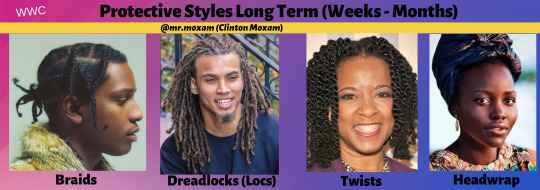
Protective Styles Long-term (lasting weeks to months+)
Braids (endless styles and patterns. Typically smaller braids last longer)
Cornrows
Dreadlocks/locs (permanent style, research the hair care)
Extensions
Flat Twists /Twists
Head wraps and hats (endless wrapping styles, colors and patterns!)
Wigs (unless glued, hair maintained underneath or often put in braids)
Writing Takeaway - Protective Hairstyles
Protective styles are an amazing way to protect the character’s hair and would very likely be the go-to for any natural in an uncertain or fast-paced environment. Just in everyday life they’re highly worn so it would especially be the case! Just remember the character needs to eventually undo whatever protective style they have installed to do some hair maintenance (washing, detangling, etc) and give their strands a rest. Also, even hair in protective styles need some attention.
Curly Hair Type and Associated Needs
Determining your hair type is important to knowing its needs. Certain ingredients work best for certain hair types. However everyone is unique and there are more factors to consider than just curl pattern (Also, most curly folks cross into a mix of hair types). There is hair thickness (width & density) and how much moisture and product your hair absorbs (porosity) to consider as well.
I will only cover curl pattern and the commonly associated needs here. To learn more about porosity, width, and density check out the FAQ under the read more.
naturallycurly.com is a great resource and is the source for the images, terms, and information provided below.
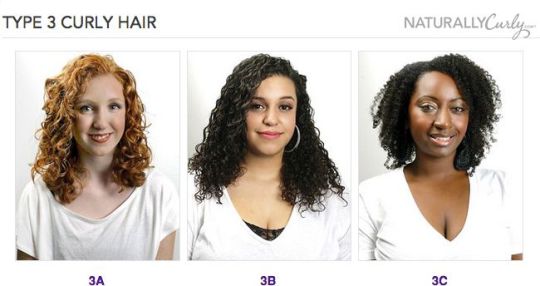
Curly Twirly (3A)
Defined loopy “S” pattern. Curls well defined and springy. Big, loose and shiny. Size: Sidewalk chalk size.
Best Products: Gels and creams with light moisture and curl definition.
Curly Spirally (3B)
Well-defined, springy copious curls that range from bouncy ringlets to tight corkscrews. Size: Sharpie size.
Best Products: Gels and styling creams with extra moisture and frizz control.
Curly Kinky (3C)
Voluminous, tight corkscrew curls. Either kinky or very tightly curled, with lots of strands densely packed together. The very tight curls are usually fine in texture. Size: Pencil.
Best Products: Styling creams, butters, and oils. Needs gentle care.

Coily Springy (4A)
Well-defined “S” Pattern. Tight, coily, and the most fragile curls.
Size: Crochet Needle or smaller.
4A Best Products & Tips: Styling creams, butters, and oils.
Clarify scalp with tea tree or jojoba oil during washes
This hair needs extra moisture and tender care
Be gentle when handling and detangling hair to avoid stress & breakage
Use thick moisturizers like mango and shea butters to maximize styles
Coily Crimpy (4B)
Less-defined “Z” Pattern. Tight, coily fragile curls. Hair bends at sharp angles.
4B Best Products & Tips: Styling creams, butters, and oils.
Add moisturizing oils before washing (pre-poo/pre-shampoo) with coconut or castor oil to help retain the natural oils in scalp
Do heat-free styles on stretched hair for maximum definition and less frizz
Air-dry hair whenever possible, or use soft cloth to gently dry.
Terry cloth will strip hair’s natural moisture and cause tension on strands
Coily Ziggly (4C)
Tight, coily, fragile curls. Curl pattern won’t clump without styling. Little to no visible definition.
4C Best Products and Tips: Styling creams, butters, and oils.
Use a cleansing conditioner with slippery elm or marshmallow root
Use a creamy humectant [like honey] as a leave-in to maximize protection
A curl defining custard or gel can stretch the coils safely for styled looks
Read the full guide here: Curly Hair Guide: What’s YOUR Curl Pattern?
Writing Takeaway - Hair type and needs
While hair type is just the start of all the intricacies of natural hair needs, it’s definitely a good start. There are other important parts to consider for real life naturals, but going off from hair type and the commonly associated needs should be enough for a story. (But read the FAQ under the read more to keep learning)
Do not get lost in the details, especially for a story that won’t need to cover tons of it. Learn enough to know what you’re talking about and can describe hair care accurately for situations that would affect hair.
Writing Takeaway - Overall:
You don’t have to be lavish in detail, but acknowledging how hair is handled here and there or in a dedicated section is thoughtful and satisfying to see included. It’s also a neutral way to show race without the use of micro-aggressions or racism. Finding the time and means for proper hair care would be a part of their life and potentially a stumbling block on the adventure, so mentioning how hair is handled during these circumstances is a fine idea.
It’s also a great means for representation.
–Mod Colette
Additional Info:
The following information will be nestled under the read more:
Hair Routine Samples - One super simple and one complex hair routine
Hair Straightening - Not ideal to maintain in survival situations, but also was a means of survival and daily living during some historical contexts
FAQ - Would any of this matter during the apocalypse? And what about natural products that attract bugs? Plus more.
Keep reading
25K notes
·
View notes
Text
Masterlist of Resources
Blogs
Writing With Color - this blog is an invaluable resource for creators who want to properly represent people of color. it is run by multiple people and is very well researched and very well run
Posts / Articles
Maintenance of Natural (Curly) Hair - if i could make out with a post, this would be the one. this post is a very thorough guide to hair maintenance for people with curly hair
8 notes
·
View notes
Text
Welcome!
This is a blog dedicated to worldbuilding! It will be mostly reblogs and lists of content I find helpful.
Masterlist of Resources I Use
Masterlist of my own posts
Worldbuilder’s Union Discord Server
About me
Upcoming posts! Get a peek at what’s to come :)
Credit to pic-crew profile picture: https://picrew.me/image_maker/1306309
1 note
·
View note